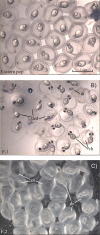First evidence for postzygotic reproductive isolation between two populations of Eurasian perch (Perca fluviatilis L.) within Lake Constance
- PMID: 18218080
- PMCID: PMC2248191
- DOI: 10.1186/1742-9994-5-3
First evidence for postzygotic reproductive isolation between two populations of Eurasian perch (Perca fluviatilis L.) within Lake Constance
Abstract
Background: The evolution of reproductive traits, such as hybrid incompatibility (postzygotic isolation) and species recognition (prezygotic isolation), have shown their key role in speciation. Theoretical modeling has recently predicted that close linkage between genes controlling pre- and postzygotic reproductive isolation could accelerate the conditions for speciation. Postzygotic isolation could develop during the sympatric speciation process contributing to the divergence of populations. Using hybrid fitness as a measure of postzygotic reproductive isolation, we empirically studied population divergence in perch (Perca fluviatilis L.) from two genetically divergent populations within a lake.
Results: During spawning time of perch we artificially created parental offspring and F1 hybrids of the two populations and studied fertilization rate and hatching success under laboratory conditions. The combined fitness measure (product of fertilization rate and hatching success) of F1 hybrids was significantly reduced compared to offspring from within population crosses.
Conclusion: Our results suggest intrinsic genetic incompatibility between the two populations and indicate that population divergence between two populations of perch inhabiting the same lake may indeed be promoted by postzygotic isolation.
Figures



Similar articles
-
Postglacial colonization shows evidence for sympatric population splitting of Eurasian perch (Perca fluviatilis L) in Lake Constance.Mol Ecol. 2004 Feb;13(2):491-7. doi: 10.1046/j.1365-294x.2003.02082.x. Mol Ecol. 2004. PMID: 14717903
-
Multiple pre- and postzygotic components of reproductive isolation between two co-occurring Lysimachia species.New Phytol. 2023 Apr;238(2):874-887. doi: 10.1111/nph.18767. Epub 2023 Feb 17. New Phytol. 2023. PMID: 36683441
-
Postmating-prezygotic isolation is not an important source of selection for reinforcement within and between species in Drosophila pseudoobscura and D. persimilis.Evolution. 2005 May;59(5):1039-45. Evolution. 2005. PMID: 16136803
-
The molecular and evolutionary basis of reproductive isolation in plants.J Genet Genomics. 2018 Nov 20;45(11):613-620. doi: 10.1016/j.jgg.2018.10.004. Epub 2018 Nov 5. J Genet Genomics. 2018. PMID: 30459118 Review.
-
[Genetics of postzygotic reproductive isolation in plants].Genetika. 2009 Jun;45(6):729-44. Genetika. 2009. PMID: 19639864 Review. Russian.
Cited by
-
The evolution of reproductive isolation in Daphnia.BMC Evol Biol. 2019 Nov 27;19(1):216. doi: 10.1186/s12862-019-1542-9. BMC Evol Biol. 2019. PMID: 31775606 Free PMC article.
-
Absence of postzygotic isolating mechanisms: evidence from experimental hybridization between two species of tropical sea urchins.J Zhejiang Univ Sci B. 2012 Oct;13(10):797-810. doi: 10.1631/jzus.B1100152. J Zhejiang Univ Sci B. 2012. PMID: 23024047 Free PMC article.
-
Karyotypic stasis and its implications for extensive hybridization events in corallivores species of butterflyfishes (Chaetodontidae).Heliyon. 2024 Mar 5;10(6):e27435. doi: 10.1016/j.heliyon.2024.e27435. eCollection 2024 Mar 30. Heliyon. 2024. PMID: 38545167 Free PMC article.
-
Population connectivity: dam migration mitigations and contemporary site fidelity in arctic char.BMC Evol Biol. 2011 Jul 14;11:207. doi: 10.1186/1471-2148-11-207. BMC Evol Biol. 2011. PMID: 21756324 Free PMC article.
-
A population genetic window into the past and future of the walleye Sander vitreus: relation to historic walleye and the extinct "blue pike" S. v. "glaucus".BMC Evol Biol. 2014 Jun 17;14:133. doi: 10.1186/1471-2148-14-133. BMC Evol Biol. 2014. PMID: 24941945 Free PMC article.
References
LinkOut - more resources
Full Text Sources

